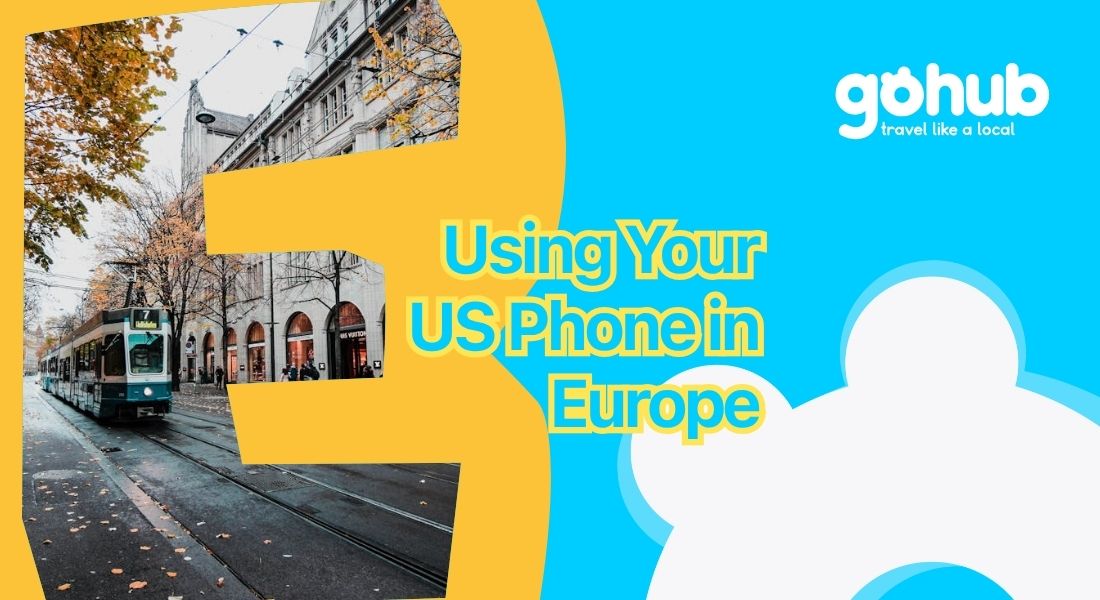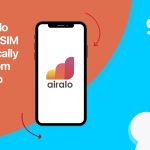The first time I landed in Europe, I confidently turned on my phone to find directions to my hostel in Rome.
Three minutes later? Ding! — “$12 international data charge applied.” Ciao, budget.
If you’re planning a trip and wondering how to use US phone in Europe without breaking the bank, you’re not alone. From hidden roaming fees to confusing SIM swaps, staying connected abroad can feel like a tech puzzle.
But don’t worry — I’ve been there. Whether you’re working remotely from a café in Lisbon, navigating trains in Munich, or uploading sunset reels from Santorini, this guide will show you the smartest, easiest, and cheapest ways to stay online.
You’ll learn:
- How to prep your phone before you fly
- The real costs of US carrier roaming
- SIM vs eSIM pros and cons
- Data-saving hacks
- And which option gives you the best value for your trip
Let’s dive in — because your Europe adventure deserves better than surprise fees and slow signal.
I. Is Your Phone Europe-Ready?
Before you start shopping for SIMs or eSIMs, let’s make sure your phone is actually ready to connect in Europe. Otherwise, you’ll be staring at a “No Service” screen while everyone else is posting gelato pics in Florence.
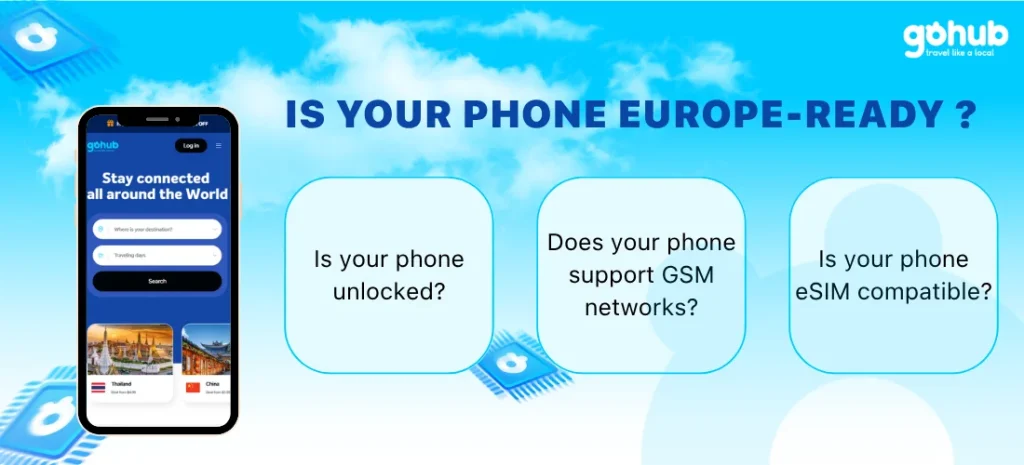
Here’s your quick pre-trip checklist:
✅ 1. Is your phone unlocked?
If you bought your phone through a US carrier (Verizon, AT&T, T-Mobile), it might be carrier-locked—meaning it won’t accept SIMs or eSIMs from other providers.
What to do:
Call your carrier and ask: “Is my phone unlocked for international use?”
If not, request an unlock—do this at least a week before you travel.
(Some carriers have eligibility rules like payment history or device age.)
✅ 2. Does your phone support GSM networks?
Europe uses GSM networks (like most of the world). Almost all modern smartphones are GSM-compatible—especially iPhones, Samsungs, and Google Pixels.
You’re likely fine if:
- You bought your phone in the last 4–5 years
- You’re using a T-Mobile or AT&T phone
(Not sure? Just Google: “Is [your phone model] GSM-compatible?”)
✅ 3. Is your phone eSIM compatible?
This is where the magic happens ✨.
If your phone supports eSIM, you can download a European data plan instantly—no shops, no shipping, no SIM swapping.
Most iPhones from XS and up and many Android flagships (like Pixel 4+, Galaxy S20+) support eSIM.
👉 Check eSIM compatibility here: GOHUB eSIM phone list
Tech Tip from GOHUB:
If your phone isn’t eSIM-ready, you can still use a physical SIM in Europe—as long as it’s unlocked and GSM-compatible. But if you want the easiest, smoothest option, eSIM is the way to go.
II.3 Smart Ways to Use US Phone in Europe Without Roaming Fees
Once your phone is unlocked and compatible, it’s time to choose how you’ll stay online while traveling. Here are the three main options—ranked from “easy but expensive” to “clever and cost-effective.”
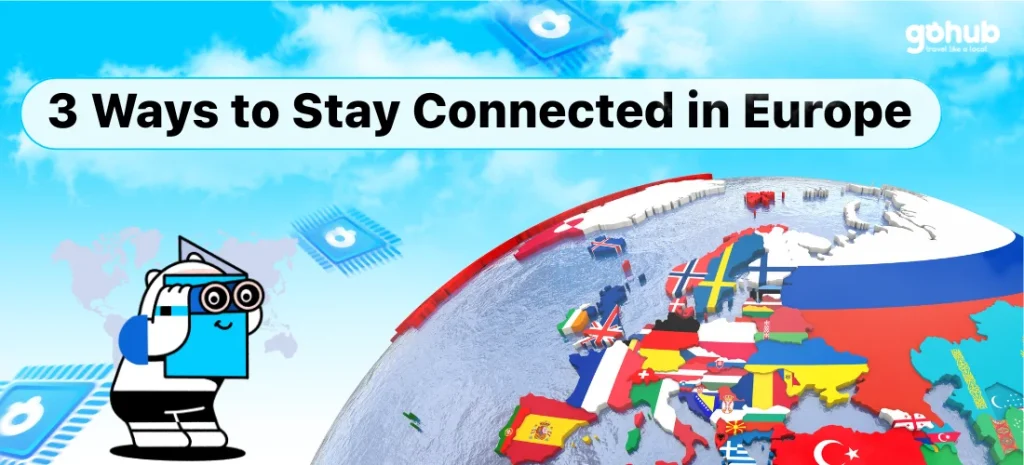
OPTION 1: Use Your US Carrier’s International Plan
Easiest to set up — but your wallet might cry.
Most major US carriers offer international roaming packages so your phone works abroad just like at home.
| Carrier | Plan | Price | Includes |
|---|---|---|---|
| Verizon | TravelPass | $12/day | Uses your US plan data/texts |
| AT&T | Intl Day Pass | $10/day | Same as above |
| T-Mobile | Basic roaming | Free 2G + paid upgrades | $5–$50 data passes |
Pros:
- No setup required—just land and it connects
- You keep your US number active for calls/texts
Cons:
- You’re charged per day, even for light use
- Data is often slower (especially T-Mobile’s default 2G)
- Over a 2-week trip, you could pay $140–$168+ just for staying connected
“It’s fine for a quick business trip, but for backpacking across Europe? Nope.”
OPTION 2: Buy a European Physical SIM Card
Cheap data—but comes with some effort.
You can buy a prepaid SIM in Europe and pop it into your phone (if it’s unlocked). This gives you a local number and usually plenty of data at low rates.
Where to buy:
- Mobile carrier shops (Orange, Vodafone, Three UK)
- Airports or convenience stores (less setup help)
- Online before your trip (some offer delivery)
Pros:
- Low cost per GB (e.g., 20–30GB for ~$30–50)
- EU roaming rules let you use one SIM across many countries
Cons:
- You lose access to your US number (unless you use dual SIM)
- SIM setup may require ID/passport
- Language barriers and registration hassles in-store
“Great for long stays in one country, but clunky for multi-country travelers.”
OPTION 3: Use an eSIM — The Modern, Flexible Option
GOHUB’s favorite: instant setup, multi-country coverage, and total flexibility.
An eSIM is a digital SIM you install by scanning a QR code. It gives you mobile data (and sometimes call minutes) without needing a physical SIM. Your US number stays active via your regular SIM while your eSIM handles all the internet goodness.
Why travelers love eSIMs:
✅ Activate it before or after landing
✅ No need to remove your US SIM (great for 2FA, WhatsApp, iMessage)
✅ Regional coverage (one eSIM works in 30+ European countries)
✅ Plans as low as $7.50, with more data for less than Airalo or Holafly
✅ Setup takes under 2 minutes (scan, install, go)
Compatible with iPhone XS and newer, Pixel 4+, Samsung S20+, and more.
Things to check:
- Your phone must support eSIM
- Some plans are data-only (use WhatsApp or Google Voice for calls)
“Landed in Barcelona, turned off airplane mode, eSIM kicked in, and I was booking a taxi in 30 seconds. Never going back to physical SIMs.”
III. How can I make my data last longer?
Even with a solid eSIM plan, your data can vanish faster than a pain au chocolat on a Paris morning. Streaming, background updates, and rogue apps can burn through gigs without you noticing.
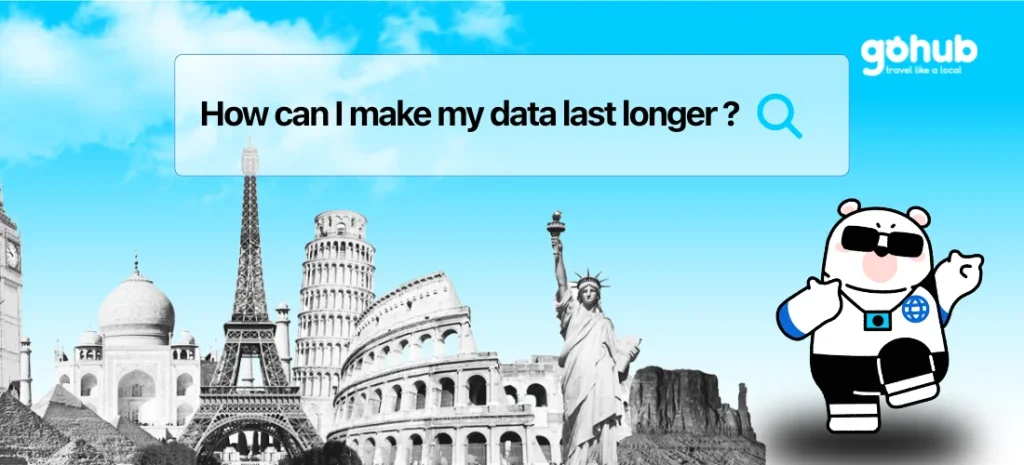
Here’s your GOHUB-approved checklist to stretch every MB and avoid data drain drama:
✅ Before You Travel
- Download offline maps (Google Maps / Maps.me) for all your destinations
- Download playlists & shows on Spotify, Netflix, YouTube (while on Wi-Fi!)
- Turn off automatic app updates (App Store / Google Play settings)
- Enable Low Data Mode (iOS: Settings > Cellular > Data Mode)
- Disable iCloud/Google Photos auto-sync over cellular
✅ While Traveling
- Use Wi-Fi whenever possible (hostels, cafes, train stations)
- Block background data for social apps (Instagram, Facebook, TikTok love to eat data)
- Switch email from “Push” to “Fetch manually”
- Use WhatsApp/iMessage for calls and texts over Wi-Fi or data
- Avoid roaming videos & live streams—download before you go!
✅ Bonus Pro Tips
🔋 Enable airplane mode + Wi-Fi only when you’re not actively using mobile data
📊 Reset cellular data counter at the start of your trip to track usage
📱 Turn off data for specific apps via phone settings
🔐 Use a VPN when on public Wi-Fi to protect your info
IV. Staying in Touch: Calls, Texts & Keeping Your US Number
Data’s important—but what about those moments when Mom calls mid-Eurotrip or your bank needs to send a 2FA code? Here’s how to stay reachable without racking up surprise fees.
🔹 If You Use a US Carrier Plan
- You keep your US number active
- Calls/texts just work, but you pay per day or per minute
- Roaming charges apply if someone calls you
- Great if you’re on a short trip and don’t want to fuss
🔹 If You Use a Local European SIM
- You get a local number
- Incoming calls/texts go to that number
- You lose access to your US number (unless you have dual SIM)
- Good for long-term travelers or those who don’t need their US number
🔹 If You Use an eSIM (Best Combo!)
- Keep your US number active on your physical SIM (for 2FA, banking, WhatsApp, etc.)
- Use your GOHUB eSIM for fast, cheap data across Europe
- Most eSIM plans are data-only, but some offer EU call minutes
- Make voice/video calls with WhatsApp, FaceTime, Google Voice, or Zoom
“I booked my flight, confirmed my Airbnb, and called my mom—all through WhatsApp over data. Didn’t pay a cent in roaming fees.”
Extra Call Tips
Enable Wi-Fi Calling
- On iPhones/Android, you can call US numbers via Wi-Fi for free
- Just make sure you activate it before leaving the US
Use Google Voice
- Create a free secondary US number
- Make/receive US calls via data or Wi-Fi
- Great for work calls or staying reachable without using your main line
With an eSIM + dual SIM setup, you get the best of both worlds: cheap Europe data and your US number stays alive for texts, banking, and emergencies. 🙌
💡 First time traveling to Europe solo?
Don’t miss our guide on how to plan your first solo Europe trip on a budget — with tips on hostels, train passes, eSIMs (yep, like this one), and how to stretch every euro.
V. Final Tips + Which Option Should You Choose?
So, what’s the best way to stay connected in Europe?
The truth is: it depends on your travel style—but one option offers the best balance of convenience, flexibility, and value for most travelers.
Quick Recap: Your Options Compared
| Option | Best For | Pros | Cons | Estimated Cost |
|---|---|---|---|---|
| US Carrier Plan | Short trips | Easy, keeps US number | Expensive, limited speeds | $10–12/day |
| Local SIM | Long stays in one country | Cheap data, local number | Setup hassle, lose US number | $25–50 |
| eSIM (GOHUB) | Multi-country, modern travel | Easy setup, dual SIM, great rates | Phone must support eSIM | From $7.50 |
Final Pre-Trip Checklist
✅ Phone is unlocked
✅ Phone supports eSIM (check here)
✅ Downloaded offline maps & playlists
✅ Installed data-saving settings
✅ eSIM QR code saved (or installed)
✅ WhatsApp & Wi-Fi calling enabled
✅ Power bank packed 🔋
GOHUB’s Honest Recommendation:
If you want fast, reliable data, plan to visit multiple countries, and don’t want to deal with physical SIM cards or roaming fees—
👉 GOHUB eSIM Europe is your best travel buddy.
You can:
- Stay connected in 30+ countries
- Pay up to 50% less than Airalo or Holafly
- Set it up in under 2 minutes
- Keep your US number active for texts and logins
- Get 24/7 support from real travel humans (like us 👋)
Ready to Stay Connected the Smart Way?
✨ Get Your GOHUB Europe eSIM Now — from $7.50, no roaming fees, full control.
Travel smart. Spend less. Experience more.
VI. FAQs
🔹 Can I use my US phone in Europe?
Yes, most modern US smartphones (especially iPhones, Samsung Galaxy, and Google Pixel) can work in Europe—as long as your phone is unlocked and supports GSM networks. You may need to activate international roaming or use a local SIM or eSIM.
🔹 Will my Android phone work in Europe?
Most Android phones work fine in Europe if they’re GSM-compatible and unlocked. Phones bought from T-Mobile and AT&T usually work well. Verizon phones made after 2018 often support GSM too—just check your model’s specs.
🔹 How do I use my iPhone in Europe without charges?
To avoid surprise roaming charges:
- Turn off cellular data or roaming
- Use Wi-Fi only, or
- Install a travel eSIM (like GOHUB) with prepaid data
This lets you use your iPhone abroad without touching your US carrier’s expensive international plans.
🔹 Is there an app to help me use my phone in Europe?
There’s no single app that “unlocks” your phone for Europe, but you can use apps like:
- WhatsApp, Google Voice, Skype – to call/text over Wi-Fi or data
- eSIM apps like GOHUB – to install and manage international data plans
- My Verizon, T-Mobile, etc. – to track your roaming charges (if using carrier plans)
🔹 What’s the best prepaid phone or plan for Europe travel?
If you already own a compatible phone, the best option is a Europe travel eSIM. GOHUB offers plans from $7.50 with coverage in 30+ countries, and no roaming fees.
If you want a separate device, some travelers also buy a cheap Android phone with a local SIM.
🔹 Can I use T-Mobile in Europe?
Yes, T-Mobile includes basic roaming in many Europe destinations. But the speed is often limited to 2G, unless you pay for a high-speed data pass. For better performance, many travelers prefer getting an eSIM or local SIM.
🔹 Does the Samsung US version work in Europe?
Most Samsung Galaxy US versions (especially from the S10/S20/S21 lines and up) work in Europe—but only if unlocked and GSM-compatible. Verizon models can be trickier, so double-check the supported frequency bands.


